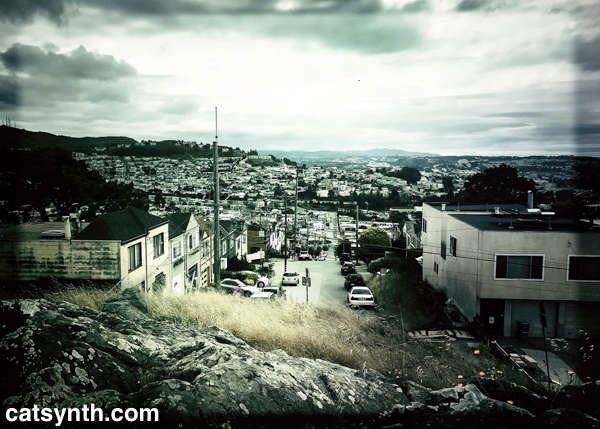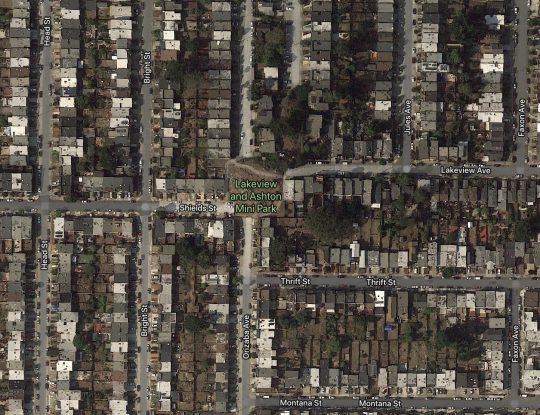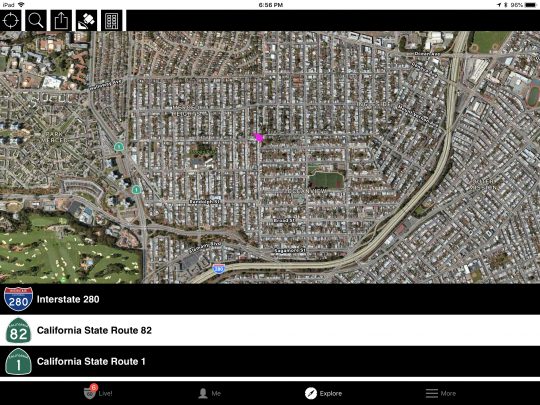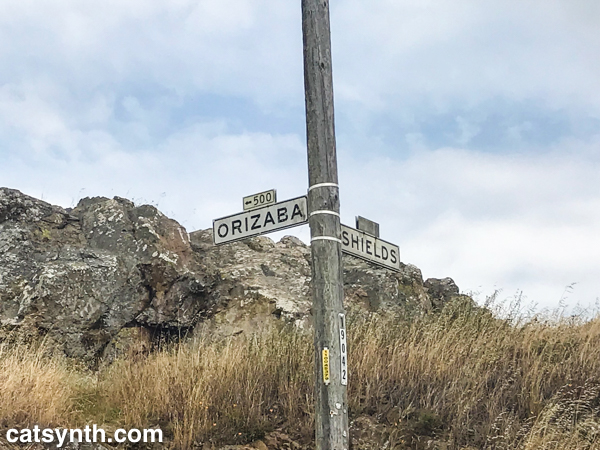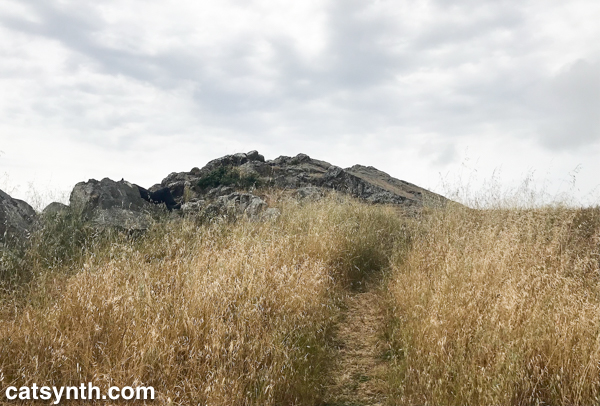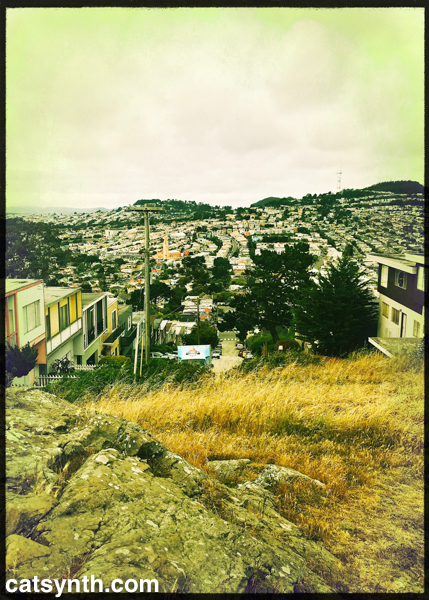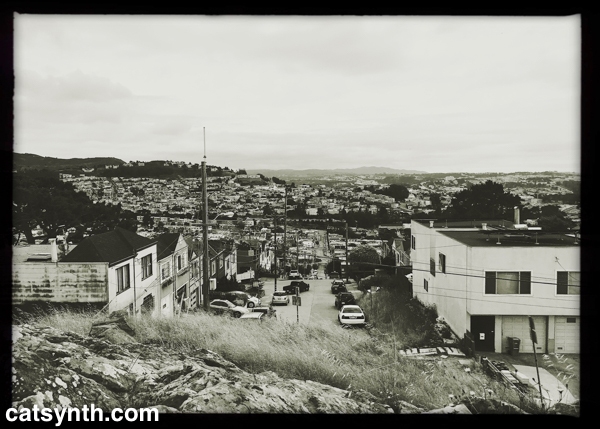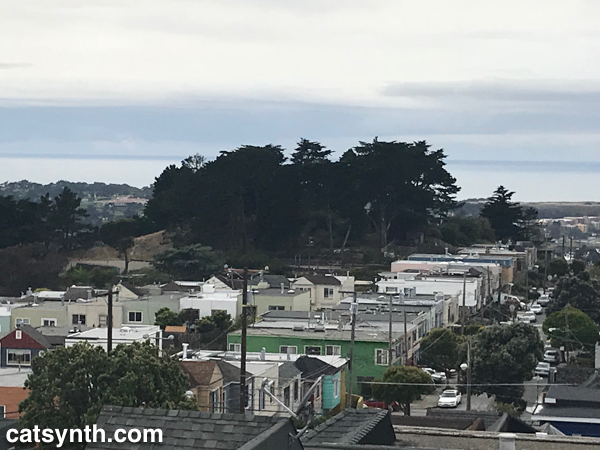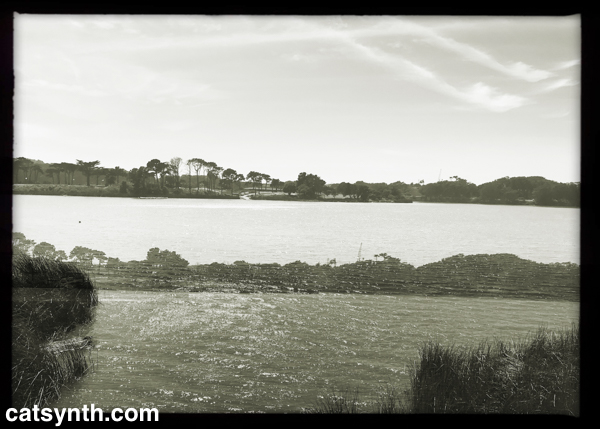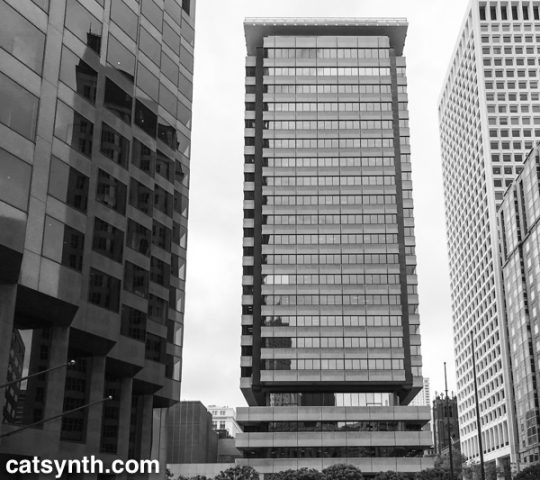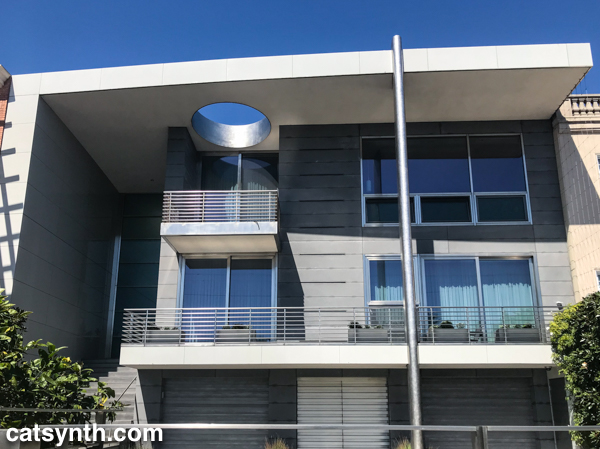Looking south on Orizaba Avenue in southwestern San Francisco from Lakeview and Ashton Mini Park. You can read more about our visit to this spot in this article.
San Francisco
Lakeview and Ashton Mini Park, San Francisco
Many years ago, I noticed a small rock that appeared to be in the middle of the street at the top of a hill in the Ingleside neighborhood of San Francisco. I also noticed it a few times while traveling on BART. Turns out it is, in fact, an official San Francisco Park, the Lakeview and Ashton Mini Park.
It really is just a speck of undeveloped land on the crest of a hill in the middle of Ingleside, a largely residential neighborhood wedged between I-280 and CA 1 (19th Avenue).
From the official San Francisco Parks guide:
This rocky outcrop is part of a ridge of sandstone in the Merced and Ingleside Heights neighborhoods. While the park is very small, its grassy and rocky slopes are home to a variety of native plant species, including buckwheat, dudleya, farewell-to-spring, coast onion, and soap plant. This diversity of plants means there are flowers in bloom at Lakeview/Ashton Mini Park through most of the spring and summer. This wide window of flower availability provides a crucial long-term food source for many local butterflies and other insects. In 2003, a locally rare arboreal salamander was found hiding amongst the rocks. This relatively large brown salamander, four inches long when mature, has a whitish belly that in juveniles is darker and covered with light-blue spots. Arboreal salamanders have tails that are well adapted for grasping branches to help climb trees.
A couple of weeks ago, I decided to go check finally it out up close. I made my way up the steep incline of Orizaba Avenue to the park, which also marks the ends of Shields and Lakeview Streets.
As I had recalled from when I first noticed it, the park is dominated by a large mound of rock surrounded by tall scrub grass. But there is a path through the grass to the top of the rock.
And from the top of this rock is a fantastic and perhaps underappreciated view of the southwestern section of San Francisco. Looking north along Orizaba, we see a wide swath of western San Francisco, including Forest Hill, Golden Gate Heights, and Mount Davidson (the highest natural point in the city). We also see the iconic Sutro Tower peeking out from behind.
Looking south, we see the Ingleside and Sunnyside neighborhoods, bisected by I-280 and BART. Beyond are the hills of Daly City and San Bruno mountain.
The Pacific Ocean is visible in the distance to the west. Closer by within Ingleside is another, larger park, with a copse of trees on top.
I did not visit the other park on this day.
This was a lovely spot, and I lingered there for quite a while despite the chill in the air. It was, however, not entirely immune from the current problems of San Francisco, with a few signs of recent homeless and drug-use activity. But overall, it was clean and quiet. I will come back when I find myself in the vicinity again.
The western neighborhoods of the city still have a lot of secrets to offer, and I am eager to discover them.
UnPopular Electronics (Robair + Djll), Lx Rudis, Franck Martin at Robotspeak
It’s been a little while since we last attended Church of Thee Super Serge at Robotspeak in San Francisco, but we made a point of going this past weekend. For those who have not been there or read our past reviews, it’s an almost-ever-month show on a Saturday afternoon with live hardware-synthesizer performances. As the name suggests, some acts do include Serge synthesizers, but it is not required, and a wide variety of instruments are used. All three sets are featured in our most recent CatSynth TV episode.
The first set featured Lx Rudis performing on an Oberheim Xpander, a somewhat underappreciated instrument from the 1980s.
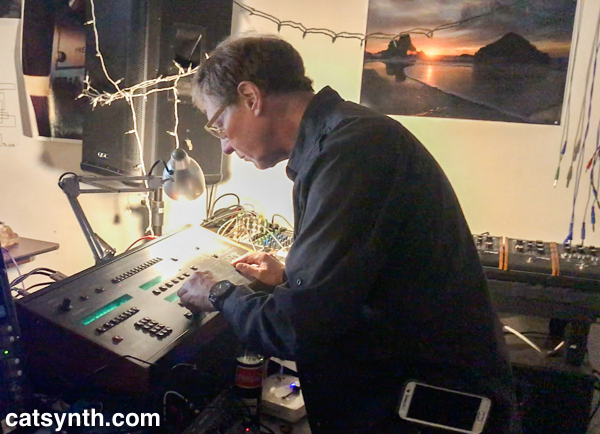
At its heart, the Xpander is a 6 voice analog synthesizer, but with a complex array of digital controls that can be programmed and applied independently to each voice. Lx Rudis took full advantage of these, especially the LFOs and lag generators, to create subtle and minimal metric patterns. He constantly moved voices in and out, configuring them on the fly, in a way that was very expressive and musical. I particularly liked the sections which had staccato rhythmic textures against slowly moving timbres deliberately out of sync with one another.
Next up was Franck Martin, who performed a solo set on a modular synthesizer with several standalone instruments.
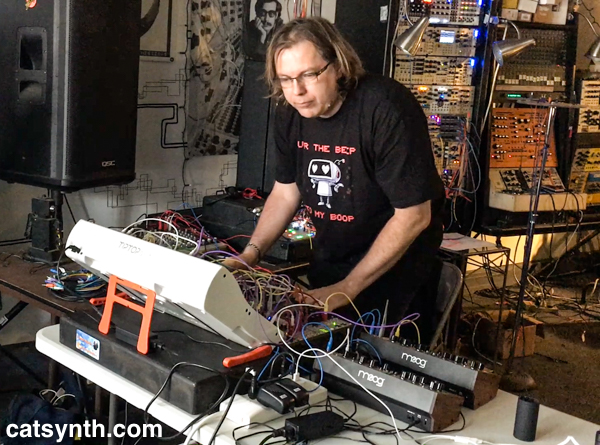
Martin’s setup included a Moog Subharmonicon, which he built while attending Moogfest this year (we at CatSynth are a bit envious), as well as a DFAM (Drummer From Another Mother). There were also additional voices provided by Braids and Plaits modules from Mutable Instruments that he could bring in and out using a touch-plate interface. The result was a slowly changing beat pattern with an eerie inharmonic voicing and gentle undulation.
The final set featured our friends Gino Robair and Tom Djll teaming up as the brilliantly named Unpopular Electronics.
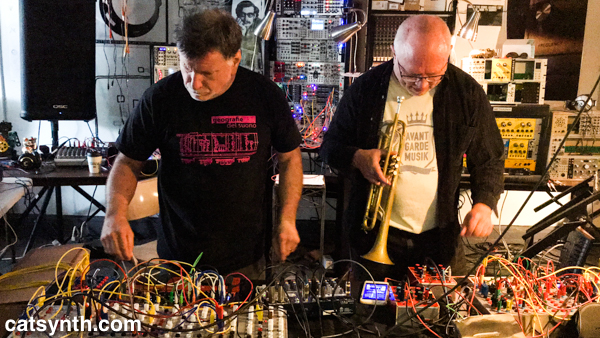
They had a wide variety of gear, including Serge panels in addition to Eurorack modules and standalone instruments from Bugbrand and others. In addition, Gino had an interesting small case that included touchpads.
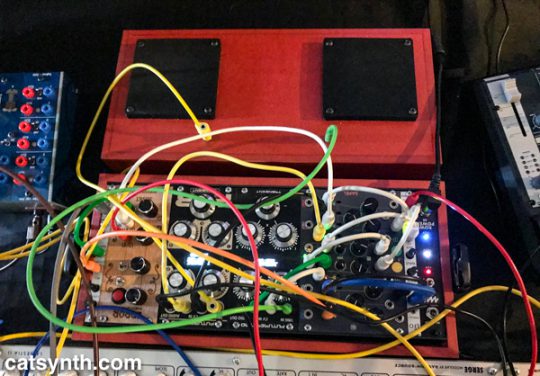
The music was frenetic and intense, an avalanche of pops and hits and loud cloudlike tone clusters. And there were trumpet sounds entering into the mix at various points. But there was an exquisite detail to the madness with changes among the different instruments and sounds, and musical pauses and rests before the pair dived back into the frenzy. There were also many moments of humor and not just Djll’s book about why there aren’t any Zeppelin-style airships in the United States.
In between sets, it’s fun to browse around Robotspeak and see what’s for sale, or on display in the big glass case.
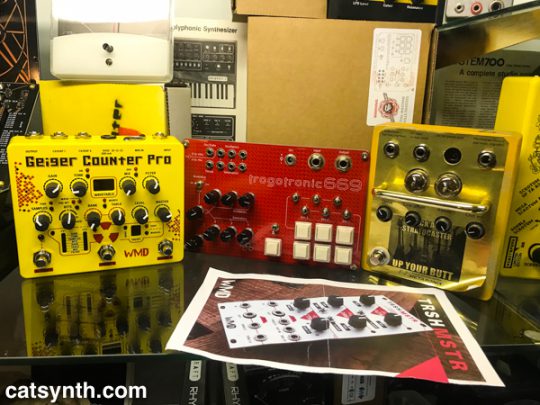
It’s also quite dangerous, as I am often tempted to leave with another module or instrument. On this occasion, I exercised restraint, but probably not next time…
Denny Denny Breakfast at the Luggage Store Gallery, San Francisco
A couple of weeks ago we saw a fun and intriguing performance by Denny Denny Breakfast at the Luggage Store Gallery in San Francisco. It was the subject of a recent CatSynth TV.
Denny Denny Breakfast is an ensemble project led by Robert Woods-LaDue. The personnel changes per event, but on this occasion, it included Sarah Dionne Woods-LaDue (dance), Mark Clifford (vibraphone), Crystal Pascucci (cell0), Jordan Glenn (drums), David Young (keyboard), Max Judelson (upright bass), and Rent Romus (alto saxophone). They had recorded an album together in December 2017 and the mix of improvisations and noted sections informed the live performance at the Luggage Store.
Several of the parts were improvised once again, but others were relatively fixed, including the final piece that was a note-for-note transcription of an improvisation from the recording sessions. There was also a piece originally conceived while the group was playing in the Finnish Hall in Berkeley but did not make it onto the album. It was a simple concept of repeated patterns slowly changing in speed between two groups of performs, creating a phase pattern in the acoustic space. The Finnish Hall has very unique acoustics, and so does the third floor of the Luggage Store Gallery, making it an ideal location to recreate the piece. Throughout there was a large variation in the music between pieces, ranging from melodic and theatrical to noisy and percussive, to minimal with large amounts of empty space. Each of these styles and textures left room for the dancers Sarah and Robert Woods-LaDue to be front and center.
We were happy to have been introduced to Woods-LaDue’s work, and are enjoying his recordings as well. There is a wide variation in style among the different albums, but that will be a topic for another review in the not-too-distant future.
Wordless Wednesday: Lake Merced Abstraction
CatSynth Pic: Robotspeak
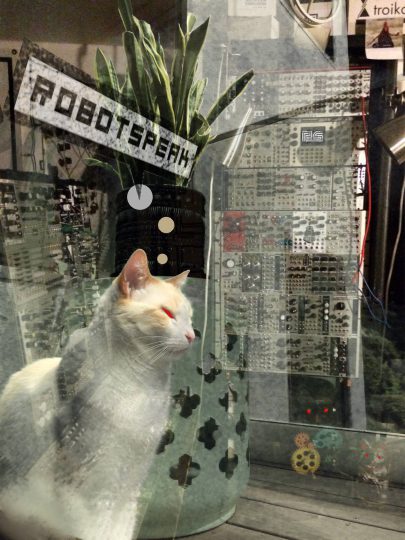
We espied this photo on the Facebook page of Robotspeak, our local synthesizer shop and informal gathering place for monthly shows here in San Francisco.
I have myself dropped quite a bit of hard-earned money there (but don’t regret any of it), and I have played there on a few occasions, including the Analog Ladies showcases. You can read about past visits to Robotspeak via this link.
Wordless Wednesday: Windmill (Golden Gate Park)
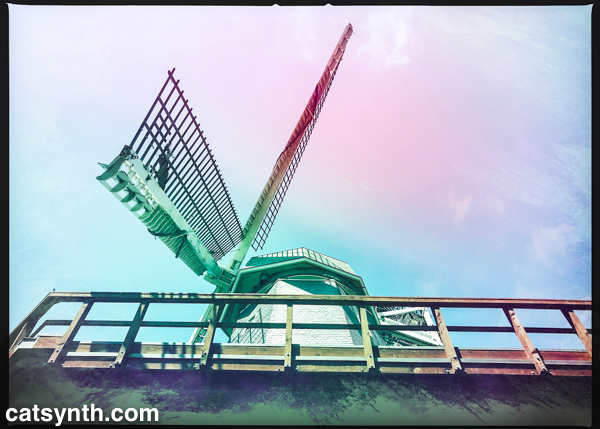
The Murphy Windmill in Golden Gate Park, San Francisco.
You can find out more about the windmill and its history at outsidelands.org
Voltage and Verse: Ruth Weiss/Doug Lynner/Hal Davis, Pitta of the Mind, Ramon Sender at Adobe Books
It’s been a busy season for Pitta of the Mind! We had three shows in the span of two months, beginning with our blue set at Pro Arts and culminating with ¡Voltage and Verse! at Adobe Books in San Francisco. You can get a taste for the show in our CatSynth TV video.
It was an honor to once again share a bill with ruth weiss. A Holocaust survivor and founding member of the San Francisco beat poet scene in the 1950s, she is still going strong, performing and supporting local institutions and artists.
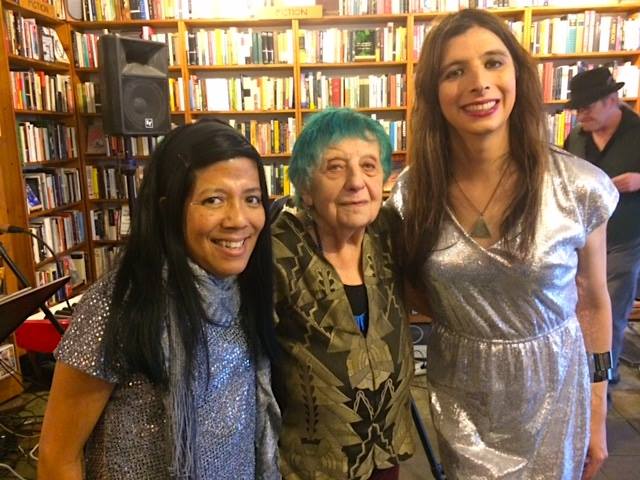
We were glad to see that she is continuing her collaboration with our friend and synthesizer virtuoso Doug Lynner. Together with log percussionist Hal Davis, they performed a set of poetry and music that simultaneously evoked earlier eras and the latest electronic experiments. Davis’ log drum provided an expressive metronome, undulating between a trot and a gallop. Lynner’s synthesizer lines filled in the spaces, sometimes with rhythmic appeggios and at other moments with long eerie drones. The synthesizer timbres and phrases complemented the words in multiple ways, sometimes underpinning the narrative in the manner of a good film score, at other times emphasizing the rhythm of the words and making them into a musical whole.
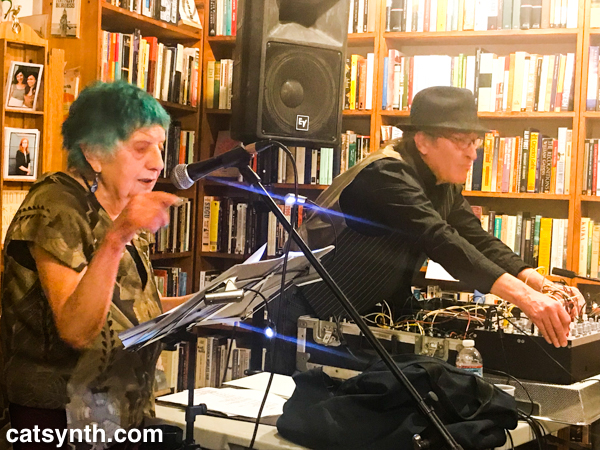
Our Pitta of the Mind set was part of a month-long celebration for the release of Maw Shein Win’s new book of poetry Invisible Gifts. The book is divided into four sections based on different colors. This works perfectly for our use of color themes in our performances. For this night, we chose silver and performed selections from the silver section of the book. There were some familiar poems that we have performed before, and some that were new to me. There were a variety of styles and subjects in the words that inspired different musical backings, from jazzy electric piano (my favorite) to abstract synthesizer explorations. I was able to reuse some of the modular patches I had developed for my recent show in Portland and make them work with the rhythm of the texts.
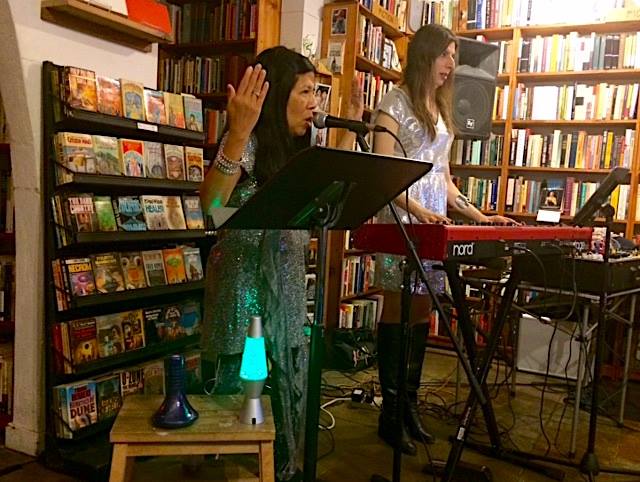
Maw and I have performed together so many times now that it has become almost second nature to realize a new set; our three shows this season went off (nearly) flawlessly, and have been among the best we have done in our nearly seven years of collaboration! We have developed a toolset and pallete of instruments (including the Nord Stage and Prophet 12) and sounds that we can quickly turn to with each new text, which makes the process of learning new pieces both simple and fun. I certainly hope we can keep up the momentum in the remainder of the year, even as I turn my own attention to other musical projects.
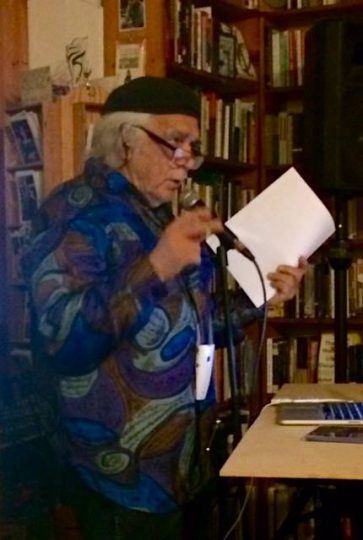
In between our set and weiss/Lynner/Davis, we were treated to a presentation by Ramon Sender. Sender was a co-founder (along Morton Subotnick and Pauline Oliveros) of the San Francisco Tape Music Center in the early 1960s, but on this evening he regaled us with stories of his time at the Morning Star and Wheeler ranches in Sonoma County in the late 1960s and early 1970s. Morningstar, founded by Lou Gottlieb, was a radical experiment in communal living, populated by an interesting cast of characters along with folks who “commuted” between San Francisco’s Haight-Ashbury district and the ranch west of Sebastopol. It only existed in its communal form for a short period of time before being shut down by Sonoma County. Sender and others then moved to the nearby property of artist Bill Wheeler, who followed Gottlieb’s lead and opened his ranch as a commune open to all. I found myself fascinated by Sender’s stories, and would love to learn more about the history of the area and these communal experiments.
It was a fun night of music and words that lived up to its billing, and I certainly hope to have a chance to perform with everyone again. And thanks to Benjamin Tinker and Adobe Books for hosting the event! Please support your local bookstores and performance spaces.
[Photos not marked “catsynth.com” in this article courtesy of Maw Shein Win.]

